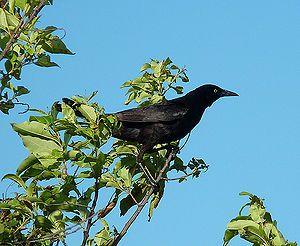One:american crow: Difference between revisions
m (Typo) |
No edit summary |
||
| (One intermediate revision by one other user not shown) | |||
| Line 4: | Line 4: | ||
Crows are adept at language, conceptual and metaphorical thought, and creative expression. Most crows appear to have a particular gift for humor and comedy. In many ways, the American Crow has a more social and collaborative intelligence than is seen in other sentient species. Crows have a particular electromagnetic sense that allows for limited non-verbal communication among crows in each other's vicinity. This sense is often referred to as "telepathy", though it does not appear to operate in the way we would normally think of telepathy, and it is certainly more limited that the telepathy seen in [[One:Cetaceans|cetaceans]]. It enables crows to have a basic, subconscious knowledge of their neighbors' emotional state, threat level and general health, without communicating specific ideas or concepts. | Crows are adept at language, conceptual and metaphorical thought, and creative expression. Most crows appear to have a particular gift for humor and comedy. In many ways, the American Crow has a more social and collaborative intelligence than is seen in other sentient species. Crows have a particular electromagnetic sense that allows for limited non-verbal communication among crows in each other's vicinity. This sense is often referred to as "telepathy", though it does not appear to operate in the way we would normally think of telepathy, and it is certainly more limited that the telepathy seen in [[One:Cetaceans|cetaceans]]. It enables crows to have a basic, subconscious knowledge of their neighbors' emotional state, threat level and general health, without communicating specific ideas or concepts. | ||
==Citations== | ==Citations== | ||
[[One:Batavia Excession|Batavia Excession]] | * [[One:Batavia Excession|Batavia Excession]] | ||
* [[One:Cetaceans|Cetaceans]] | |||
[[One:Cetaceans|Cetaceans]] | |||
[[Category: | [[Category:What came after/Turn A]] | ||
[[Category:What came after]] | |||
Latest revision as of 10:28, 8 September 2012
The American Crow (Corvus brachyrhynchos) is a large passerine bird species of the family Corvidae. It is a common bird found throughout much of North America, and it is the only species of bird known to have become sentient following the supercollider accident now known as the Batavia (or Tertiary) Excession.
Long considered one of the smartest birds, the crow's intelligence has skyrocketed in the years since the Batavia Excession, and today most corvidologists consider crows to be sentient, sapient and self-aware beings, a belief backed up by legislation passed in most major North American nation-states granting the American Crow full responsibilities and protections under the law.
Crows are adept at language, conceptual and metaphorical thought, and creative expression. Most crows appear to have a particular gift for humor and comedy. In many ways, the American Crow has a more social and collaborative intelligence than is seen in other sentient species. Crows have a particular electromagnetic sense that allows for limited non-verbal communication among crows in each other's vicinity. This sense is often referred to as "telepathy", though it does not appear to operate in the way we would normally think of telepathy, and it is certainly more limited that the telepathy seen in cetaceans. It enables crows to have a basic, subconscious knowledge of their neighbors' emotional state, threat level and general health, without communicating specific ideas or concepts.
